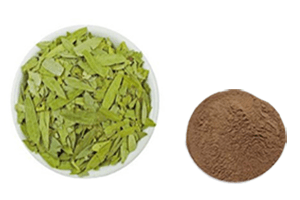Senna Leaf PE
[product name]: senna leaf glucoside
[English name]: senna leaf P.E
[product source]: This product is the dried leaflet of Cassia angustifolia Vahl or cassia acuti folia delile.
[product specification]: Senna 8% - 20%
[product appearance]: brown fine powder

[introduction to senna leaf]:
Senna is a shrub that grows in India, Pakistan, southern China and many other places. Its name is derived from the Arabic word "Sena" and has been used in ancient Indian and Greek medicine since the 9th century. The shrub can grow to about two feet tall, with green stems, pods and yellow spade shaped leaves. Its alternate leaves are evergreen, with four to five pairs of lanceolate or obovate gray green fragile leaflets. Flowers small, yellow, with five clawed irregular petals. The fruit is enclosed in a rectangular pod about 5 cm long. Leaves and pods or fruits are used medicinally.
[plant form]:
It is 1.5-5cm in length and 0.4-2cm in width. The whole leaf is sharp at the end and slightly asymmetric at the base. The narrow leaf Senna is a small herbaceous shrub with a height of 1 m. Double pinnate compound leaves, 5-8 pairs of leaflets, with short stalk; stipules ovate lanceolate, 2-4mm long; leaflets ovate lanceolate to linear lanceolate, apex acute, base slightly asymmetric, glabrous or few glabrous. The raceme is axillary, with 6-14 flowers; the peduncle base has an oval bract, easy to fall; sepals 5, long oval; petals 5, obovate, yellow; stamens 10, upper 3 small, sterile, central 4 equal length, lower 3 downward curved, anthers slightly square, base arrow shaped, 4-chamber; pistils curved like sickle, ovary with handle, sparse hair. The surface of the leaves is light green, the back of the leaves is gray green, slightly hairy, without embossing, thin and crisp. Dry, narrow and sharp leaves, large and complete leaves, green color, few stems and no mud sand were the best, followed by small leaves, yellow color, stemmed, broken leaves and mud sand. The upper surface is yellow green, the lower surface is light yellow green, glabrous or nearly glabrous, and the veins are slightly raised. Leathery. The Qi is weak and specific, the taste is slightly bitter and slightly sticky. The sharp leaf Senna is lanceolate or long ovate, slightly curly, with short tip or slightly convex leaf tip, asymmetric leaf base, and fine short trichomes on both sides.
[active ingredients]:
Senna angustifolia contains sennoside C, i.e. Rhein aloe emodin diachronone-8,8 '- diglucoside. Pods contain not only sennoside A and B, but also glucosides of rhein and chrysophanol, and trace aloe emodin or emodin glucoside. The senna leaf and pods contain 0.85-2.86% and 2.34-3.16% of xanthic acid, aloe emodin, a small amount of chrysophanol and sennoside a, B and C, respectively. These anthracene components are all glucosides. The plant also contains 3,5-dimethyl-4-methoxybenzoic acid. Senna auriculata contains tannin, anthocyanin in leaves and polyphenoloxidase in bark.
[chemical composition]:
Sennoside a, B, C, D, chrysophanol glucoside, emodin glucoside, Rhein glucoside, aloe emodin glucoside, emodin-8-o-sophoricoside and other anthraquinone glycosides are mainly contained in sennoside. Senna cuspidata mainly contains sennoside a, B, C, chrysophanol glucoside, emodin glucoside, Rhein glucoside, aloe emodin glucoside, emodin-8-o-glucopyranoside and other anthraquinone glucosides.